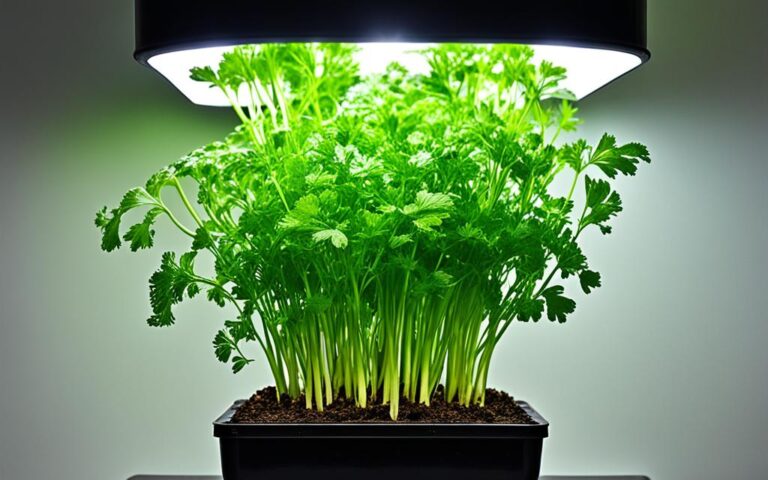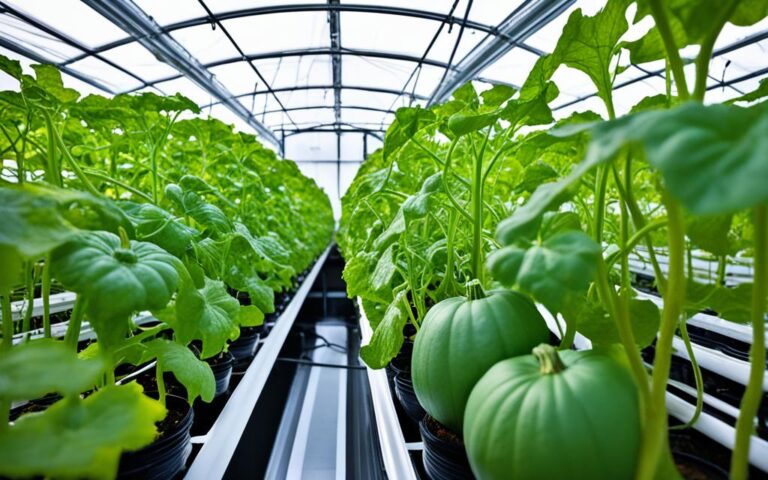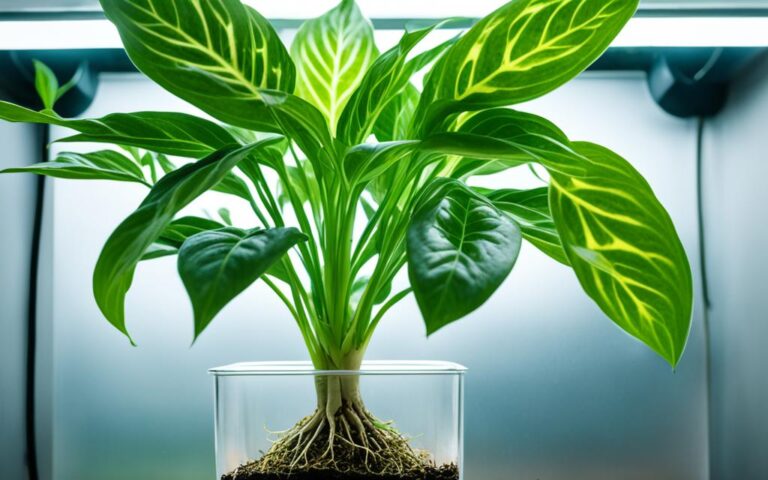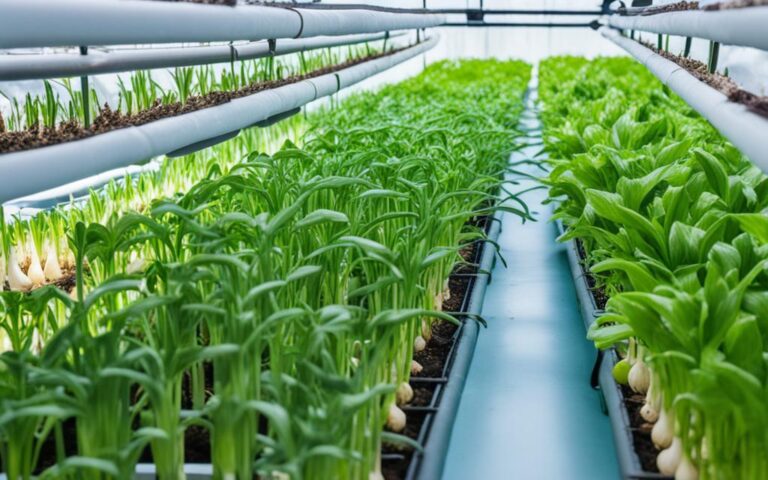Growing Hydroponic Sage: Tips & Techniques
Did you know hydroponic sage can produce up to 50% more essential oils than traditional sage? This makes it a top choice for gardeners at home and in large-scale farming. By using hydroponics, you can bring out the best in this versatile herb. We’ll cover everything you need to know to grow hydroponic sage, from setting up your system to harvesting and storing your crop.
Key Takeaways
- Hydroponic sage can produce up to 50% more essential oils than soil-grown sage
- Sage can be slow to germinate, so consider propagating from cuttings
- Proper nutrient management, pH control, and lighting are crucial for thriving hydroponic sage
- Sage is a versatile herb with a distinctive, aromatic flavor profile
- Hydroponic sage is a rewarding addition to any indoor or outdoor garden
Introduction to Growing Hydroponic Sage
For those eager to start indoor herb gardening, hydroponic sage is a great choice. It’s easy to care for and available all year. This makes it perfect for beginners looking to try growing hydroponic herbs. It can make your cooking more exciting and is easy to maintain in indoor herb gardening.
Hydroponic sage is very adaptable. It doesn’t need weeding, pest control, or worry about soil diseases. Hydroponics gives it a nutrient-rich water solution. This creates the best environment for sage to thrive. You get fresh, tasty leaves for your kitchen all the time.
Also, you can harvest hydroponic sage all year. Outdoor gardens change with the seasons, but hydroponics don’t. So, you can enjoy sage’s flavor and smell any time, no matter the weather.
“Growing hydroponic herbs like sage is a game-changer for home cooks who want to have access to fresh, flavorful ingredients year-round.”
Whether you’re a pro in the kitchen or new to gardening, growing hydroponic sage is a great step. It’s tough, versatile, and easy to care for. This plant is a great way to start a hydroponic herb garden.
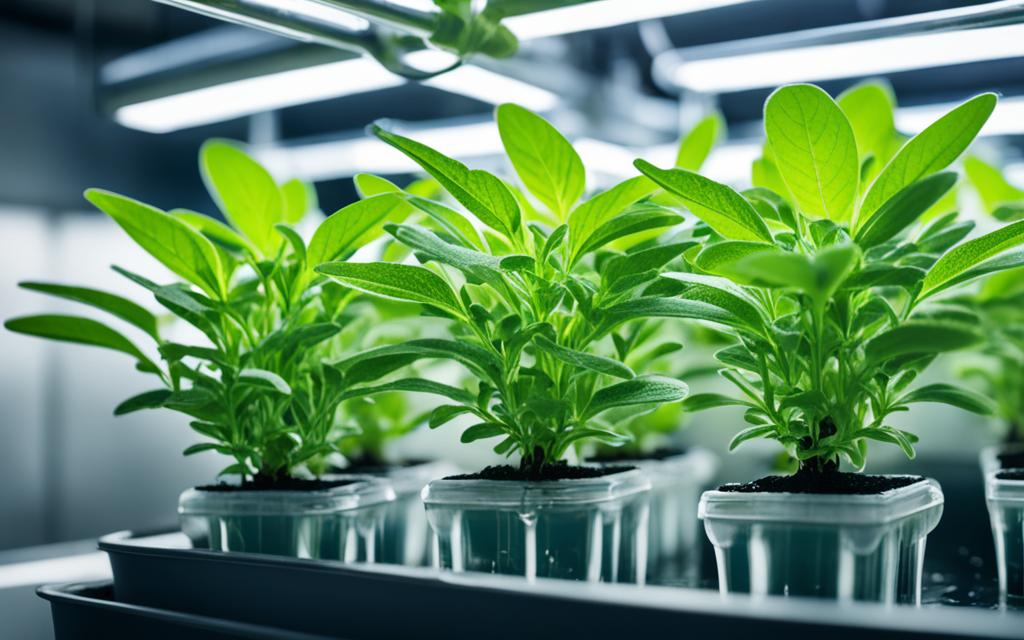
Setting Up Your Hydroponic System
Starting a hydroponic sage garden indoors means setting up your system right. You need to pick the best hydroponic sage system and make sure everything is ready. Each step is key for your plants to grow well.
Selecting the Right Hydroponic System
Choosing the right hydroponic system for hydroponic sage depends on a few things. Think about the space you have, your budget, and what sage plants need. Here are some top choices for growing sage:
- Deep water culture (DWC)
- Hydroponic grow tent
- Ebb and flow (flood and drain)
- Nutrient film technique (NFT)
Essential Components for Hydroponic Sage Growth
No matter the hydroponic sage setup you pick, you’ll need certain things for your plants to do well:
- A strong and well-ventilated hydroponic grow tent or area
- Grow pots or containers that are the right size
- A reliable water pump and tubing
- Nutrients in the hydroponic solution
- LED grow lights that work well
- Good air flow with fans for intake and exhaust
Picking the right system and making sure you have everything you need will help you grow a great hydroponic sage garden. This will give you a lot of sage to enjoy.
Choosing the Right Sage Variety
Choosing the right sage variety is key to success in hydroponic gardening. Sage comes in many types, each with its own taste and growth habits. Think about leaf size, how fast it grows, and what you want to use it for when picking a sage type.
Some top choices for hydroponic gardens include:
- Garden Sage: A classic choice, known for its robust flavor and large, silver-green leaves.
- Purple Sage: A visually striking variety with vibrant purple-hued foliage, adding a touch of elegance to your hydroponic garden.
- Pineapple Sage: A delightful cultivar that boasts a sweet, fruity aroma and can be used in both savory and sweet dishes.
These best sage varieties for hydroponics each bring something special to the table. It’s important to pick the hydroponic sage cultivars that fit your taste and style.
“Choosing the right sage variety is the first step towards a thriving hydroponic garden. Each cultivar has its own personality, waiting to be discovered and celebrated.”
Learning about the different hydroponic sage cultivars lets you create a hydroponic harvest that’s just right for you. You can make your hydroponic sage harvest personal and flavorful.
Germination and Seedling Care
Starting with hydroponic sage requires careful seed germination and seedling care. This stage is crucial for a strong start. Let’s look at the important steps for growing healthy hydroponic sage plants.
Preparing Seeds and Growing Medium
Start by soaking rockwool cubes in water with the right pH level for at least an hour. This makes the cubes ready for hydroponic sage germination. Then, put 2-3 sage seeds in each cube, giving them room to grow their roots.
Monitoring Germination Conditions
- Keep a warm and humid spot for healthy sage seedling care. This helps seeds germinate quickly and evenly.
- Watch the rockwool cubes for root growth and seedlings. This is important.
- When seedlings are ready, move them carefully by the leaves. This avoids hurting the hydroponic sage propagation.
Put the rockwool cubes into your hydroponic growing medium carefully. Make sure they’re secure and standing upright. This gives your young sage plants a great start in your hydroponic setup.
“The key to successful hydroponic sage cultivation lies in the attention to detail during the germination and seedling stages.”
Nutrient Management
Getting the right balance of nutrients is key for hydroponic sage. Like other plants, sage does well with a good nutrient mix. Make sure the electrical conductivity (EC) is between 1.0 and 1.6 to avoid too much or too little.
The best pH for hydroponic sage is 5.5 to 6.0. Sage likes a slightly acidic soil. This pH helps the plant take in nutrients better and grow strong.
Essential Nutrients for Hydroponic Sage
- Nitrogen (N) for healthy foliage development
- Phosphorus (P) for strong root growth and flowering
- Potassium (K) for improved disease resistance and overall plant vigor
- Calcium (Ca) and Magnesium (Mg) for sturdy stems and vibrant leaves
- Micronutrients such as iron, boron, and zinc for optimal plant function
Adjusting pH and EC Levels
Keep an eye on the hydroponic sage pH and hydroponic sage EC levels. Use pH up or down to adjust the pH. Also, add or dilute the nutrient solution to keep the EC right.
“Proper nutrient management is the foundation for growing healthy, flavorful hydroponic sage.”
Light and Temperature Requirements
Cultivating hydroponic sage needs careful attention to its light and temperature. It loves bright, direct sunlight for 14 to 16 hours a day. Make sure your grow lights give the right amount of light for your sage plants.
Sage does well in a warm place. Daytime temperatures should be between 70-75°F, and nights should be 60-65°F. Keeping these temperatures right is key for the plant to grow strong and healthy. Also, keep humidity at 40-50% to avoid mold or mildew.
| Hydroponic Sage Requirements | Optimal Levels |
|---|---|
| Light | 14-16 hours of bright, direct light per day |
| Temperature | Daytime: 70-75°F, Nighttime: 60-65°F |
| Humidity | 40-50% |
By keeping an eye on the right light, temperature, and humidity, you can make a great place for your hydroponic sage. This ensures you get strong and tasty harvests.
Pest and Disease Prevention
Starting your hydroponic sage journey might bring challenges like yellow leaves, slow growth, or root problems. Knowing the causes and using the right strategies can keep your hydroponic sage garden healthy.
Common Pests and Diseases in Hydroponic Sage
Hydroponic sage faces pests like aphids, spider mites, and powdery mildew. Yellow leaves mean your system might be out of balance. Make sure your roots get enough air and add beneficial microbes to help with nutrients and root health.
Integrated Pest Management Strategies
- Check your plants often for pests or diseases and fix problems quickly.
- Keep your nutrient levels and pH right to help your hydroponic sage plants stay healthy.
- Add beneficial organisms, such as predatory mites or lacewings, to keep pests under control.
- Use organic pest control, like neem oil or insecticidal soaps, to fight hydroponic sage pests safely.
- Change where you put your hydroponic system to stop hydroponic sage diseases from spreading.
- Choose organic pest control for hydroponic sage to avoid harsh chemicals and keep your garden healthy.
By watching closely and acting fast, you can keep your hydroponic sage plants healthy and get a great harvest.
“Maintaining a healthy hydroponic garden starts with a proactive approach to pest and disease management.”
Hydroponic Sage Maintenance and Pruning
Keeping your hydroponic sage plants healthy is key to their growth and productivity. Regular trimming and pruning help them grow more and give you lots of tasty leaves.
When your hydroponic sage plants get about 6 inches tall, it’s time for their first cut. Cut off less than a third of the plant’s height. This keeps your sage plants strong and helps them grow more.
For the best taste and oil content, pick your hydroponic sage in the morning. Do this after the dew dries and before the sun gets too hot. This is when the plant’s oils are strongest, giving you the best harvest.
Tips for Hydroponic Sage Maintenance and Pruning
- Prune plants once they reach 6 inches tall, removing no more than a third of the total height
- Harvest sage leaves in the morning for maximum flavor and aroma
- Regularly monitor plants for signs of pests or disease, and address issues promptly
- Ensure proper nutrient levels and adjust as needed to support ongoing growth
- Provide adequate lighting and maintain optimal temperature conditions
| Task | Frequency | Purpose |
|---|---|---|
| Pruning | Every 4-6 weeks | Encourage bushy growth and prevent leggy plants |
| Harvesting | As needed | Obtain the most flavorful and aromatic leaves |
| Nutrient Monitoring | Weekly | Ensure optimal nutrient levels for healthy plants |
By following these hydroponic sage pruning and maintenance tips, your plants will thrive. You’ll get a steady supply of fresh, fragrant sage for cooking.
“Proper hydroponic sage maintenance is the key to achieving a bountiful harvest and ensuring the long-term health of your plants.”
Harvesting and Storing Hydroponic Sage
Growing hydroponic sage is rewarding, and harvesting is the highlight of your work. It’s important to harvest and store your sage right to keep its quality and flavor.
Optimal Harvesting Techniques
Sage is very generous at harvest time. When your plant is about 6 inches tall, it’s ready for its first cut. Cutting a bit less than a third of the plant encourages more growth.
The best time to harvest is in the morning, after the dew dries and before the sun gets too hot. This is when the herb tastes and smells the best.
Preserving Sage for Long-Term Storage
- For short-term storage, wrap the leaves in a moist paper towel and put them in a plastic bag in the fridge.
- To dry and store sage for a long time, make sure the leaves are clean and dry. Once dry, put them in an airtight container in a cool, dark place.
- Storing hydroponic sage right is key to keeping its flavor and smell. This way, you can enjoy your hydroponic garden for months.
Learning how to harvest and dry hydroponic sage makes you a pro at using this tasty herb. It will improve your cooking and add a special touch to your dishes.
Troubleshooting Common Issues
Starting a hydroponic sage garden can be challenging, but with the right steps, you can fix problems and grow a healthy garden. Let’s look at some common hydroponic sage problems and how to solve them.
Yellowing leaves are a common issue. It usually means your hydroponic system is out of balance. Make sure your sage roots get enough air. Also, add beneficial microbes to help with nutrient uptake and root health.
Stunted growth is another problem. Check your nutrient ratio to make sure it fits your plants’ growth stage. Adding extra CO2 during the day can also help your sage grow better.
Drowning roots can happen in hydroponic systems. Keep the right water levels and have a good overflow system to stop your sage’s roots from getting too wet.
By being watchful and fixing hydroponic sage troubleshoot issues fast, you can keep your hydroponic sage garden healthy and full of plants.
“Troubleshooting is the process of finding and resolving problems or issues. In the case of hydroponic sage, it involves identifying and addressing any factors that may be hindering the plant’s growth or health.”
Expanding Your Hydroponic Garden
Mastering hydroponic sage is just the start. Now, you can dive into growing a wide variety of herbs and vegetables. This lets you create a lush indoor garden that meets your cooking needs.
Other Herbs and Vegetables to Grow Hydroponically
There’s more than just sage you can grow in your hydroponic setup. Think about adding these to your garden:
- Basil: Enjoy the aromatic and versatile leaves of this fragrant herb in your favorite Italian dishes.
- Tomatoes: Grow juicy, vine-ripened tomatoes that are bursting with flavor, perfect for salads, sandwiches, and sauces.
- Leafy Greens: Cultivate nutrient-rich kale, spinach, and other leafy greens for a healthy addition to your meals.
- Rosemary and Thyme: These fragrant herbs can add depth and complexity to your culinary creations.
As you grow your hydroponic garden, you’ll love the variety of herbs to grow hydroponically and vegetables to grow hydroponically. Your hydroponic system is a perfect place for them to thrive.
Expanding your hydroponic garden lets you customize it for your tastes. Try different herbs to grow hydroponically and vegetables to grow hydroponically. Find the mix that makes your indoor garden truly special.
Conclusion
Growing sage hydroponically is a rewarding hobby. It gives you a steady supply of fresh, flavorful leaves for cooking. By learning the key techniques, you can grow sage plants at home.
This journey teaches us patience, care, and the strength of nature. As you explore indoor herb gardening, let your love for fresh herbs inspire you. You can grow more herbs at home, opening up new culinary possibilities.
The benefits of growing hydroponic sage are many. You get to harvest your own herbs and have them always available. By trying hydroponic gardening, you can enjoy the many rewards of growing your own food.

